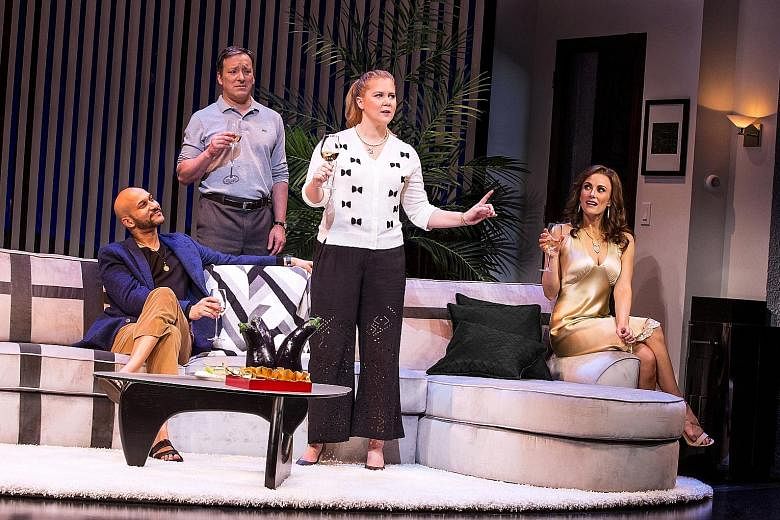NEW YORK • In June, four original dramas by highly regarded playwrights vied for the Tony Award for Best Play of the Broadway season. Three months later, all four were gone.
Their truncated lives reflect an imbalance that has all but eradicated a once thriving category of American entertainment: the commercial new Broadway play.
For decades, the theatres of Broadway - now numbering 41 - were the moneymaking breeding ground for these plays. But the traditional for-profit, new Broadway play is disappearing almost as surely as the dodo.
Three of those four nominated new plays - Indecent by Paula Vogel, Sweat by Lynn Nottage and Lucas Hnath's A Doll's House, Part 2 - were brought to Broadway by commercial producers.
The fourth, and eventual Tony winner, J.T. Rogers's Oslo, ran under the auspices of the non-profit Lincoln Centre Theater.
Despite stellar reviews and placements on all manner of top 10 lists, none lasted more than 172 performances and one closed after a mere 105. Even a mediocre musical easily laps that.
This season is looking bleaker.
Five original plays have opened thus far, three of them middling or slightly better commercial ventures counting on star performers: Amy Schumer in Steve Martin's Meteor Shower; Uma Thurman in Beau Willimon's The Parisian Woman; and Mark Rylance in Claire van Kampen's Farinelli And The King.
And only one more, the Harry Potter double bill from London, a mega-event with a brand-name appeal more like a flashy musical's, is on tap for the spring.
As a result of these trends, the playwrights of America do not aim for Broadway anymore.
The most storied platform for theatre in the country - maybe the world - is no longer the place that many of the most accomplished dramatists think of as a natural haven for their work.
"It wasn't even a dream of mine," says Young Jean Lee, a playwright in her early 40s whose sharp, funny plays about ethnic identity are produced to admiring reviews across the country.
That must sound outrageous to anyone who does not follow the goings-on of the theatre.
Is not Broadway the pinnacle of the profession, once the destination for Eugene O'Neill, Tennessee Williams and Arthur Miller, and after them, Neil Simon, Edward Albee and David Mamet?
Not for this generation.
Elbowed out by the musicals for which a ferociously tourist-driven marketplace gladly opens its wallets and drained of audience thanks to the shrinking ranks of faithful cosmopolitan customers who make possible long runs of straight plays, the works by the next O'Neills are highly unlikely to find a Broadway home.
Regional and off-Broadway companies are now the dominant incubators of new plays.
Only in the shortened runs of the non-profit theatres of Broadway, which produce plays for two-to three-month engagements, does one find a model that seems to sustain new plays.
What this means for a form that seeks to nurture important creative voices is a stunting of the American play's artistic reach and a drying-up of a means by which playwrights earn real money.
This helps explain why outstanding dramatists of our era - such Pulitzer Prize winners as Nottage, Vogel, Annie Baker, Suzan Lori-Parks, Ayad Akhtar, Quiara Alegria Hudes, Bruce Norris and Stephen Adly Guirgis - are not household names the way some of their major predecessors were.
The change in the commercial play's fortunes happened over decades, accelerating in the 1990s as Broadway's trade and marketing arms made a push to brand it as a tourist destination.
Entertainment corporations such as Disney, with a library of animated movies that it could turn into stage musicals, entered the marketplace, vying with independent producers for Broadway's few dozen commercial playhouses.
Creative powerhouses such as composer Andrew Lloyd Webber and producer Cameron Mackintosh proved in the 1980s with shows including The Phantom Of The Opera and Les Miserables that musicals could far outlive plays as moneymaking ventures and others were eager to replicate their successes.
Travel-related companies became official sponsors of Broadway and as crime rates dropped, a seedy Times Square underwent a revolutionising, family-friendly makeover.
In the late 1990s, the number of visitors to the city exploded. Between 1998 and 2016, the annual number grew from 33 million to more than 60 million, creating huge new pools of patrons for theatrical properties with broad appeal.
And musicals were largely what appealed to them.
"Audiences have increasingly been coming from out of town, and that audience is more and more attuned to musicals because that was what they were seeing in their touring houses," says Tom Viertel, a longtime independent Broadway producer.
Today, a whopping 70 per cent of Broadway's audience is tourists. "It's really put us in a position," Viertel adds, "where producing plays is the exception rather than the rule."
Peter Marks

